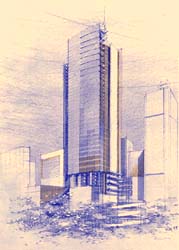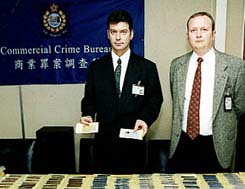



















With the commencement of preparatory works, which include the demolition of May House, Deputy Commissioner of Police (Management) Tsang Yam-pui calls on all occupants of Arsenal Yard to be patient with the inconveniences that are inevitable with such a major building project, and to keep their eyes on the outcome - a state-of-the-art complex which will serve the Force's needs well into the next century | |
 Architect's sketch of the Arsenal Yard Phase 3 Development Project |
IN announcing that funding has been secured
from Central Government to undertake preparatory works, which includes the demolition
of May House, the Deputy Commissioner of Police (Management) Tsang Yam-pui said that
"this is a major step forward in the comprehensive re-development of Police Headquarters".
Chief Superintendent (Planning & Development) David Thomas explains the project in more detail: "The Arsenal Yard Phase 3 Development project will involve the construction of a state-of-the-art complex which will serve the Force's needs well into the next century. The new complex will provide an operationally efficient and cost-effective facility for the Force. It will ultimately provide accommodation to replace May House, Caine House and Wan Chai District Headquarters and Divisional Station. The facility will accommodate the Commissioner of Police, all senior Directorate Officers, personnel from Wan Chai District Headquarters and Divisional Police Station, plus those officers from Headquarter units that are currently housed in various leased accommodation. |
|
"The project will be implemented in two stages. The first stage preparatory works
have already commenced and will be completed in June 2000. There after the
stage two works (scheduled to be completed in January 2004) will include piling
the foundation and construction of a basement structure, an integrated complex
consisting of a high-rise office tower block to accommodate Police Headquarter
units, a Wan Chai District Headquarters and Divisional Police Station, and various
support facilities such as an auditorium and indoor firing range."
The project manager, Senior Superintendent Barbara Willison, head of the Police Headquarters Development Team, further elaborates about the preparatory works: "Such work will involve not only the demolition of May House but various associated services buildings/structures, including the emergency generator room, transformer room, underground oil storage tank and the vehicle washing and refuelling facilities. Work also includes the provision of a new entrance and lobby for Caine House." As work is already underway there has and will inevitably be a degree of disruption for those working in Police Headquarters. Regarding vehicular access, traffic lights will be installed to facilitate ingress/egress via the existing Police Headquarters entrance. However, prior to installation the ingress/egress may have to be manually controlled. During the demolition and subsequent construction of May House, pedestrian access into Caine House will be through the new entrance currently being constructed in its north wing compound. Access into Arsenal House from Arsenal Street will not be affected. However, access into Arsenal House West Wing will be affected temporarily during the phased demolition of May House. For safety reasons the main Arsenal House West Wing entrance and the rear entrance from Harcourt Gardens will have to be closed until the north west corner of May House is demolished. However, staff can gain access to the West Wing from the first floor carpark of Arsenal House and the rooftop of Arsenal House. The door from Queensway will also be utilised to ease the situation and reduce inconvenience. The May House site and external carpark area will be handed over to the contractor in May 1999 followed by a reduction in the amount of space available for vehicle parking. Personnel Services Branch has arranged for temporary catering facilities in Arsenal House. It will be "business as usual" however, for the occupants of Police Headquarters, although Barbara Willison is quick to point out that patience and forbearance will be essential during the long period of inconvenience brought on by construction. "The development site will be hoarded off and in effect become a large construction site in the middle of our existing Arsenal Yard complex for some years to come. However, with the co-operation of all, in particular the invaluable assistance of our Support Bureau colleagues and especially the Police Headquarters Security Unit, we will endeavour to ease the situation and reduce inconvenience for those working in and visiting Police Headquarters. Weekly co-ordination meetings will be held with contractors to deal with any problems expeditiously. Mr Tsang further emphasised: "The new complex will enhance efficiency by permitting all Headquarters units to be accommodated within the confines of Arsenal Yard, Police Headquarters. Also the support facilities and services can be shared among different units and formations. "This prestigious yet dignified building will provide an operationally efficient, modern Police Headquarters with a user friendly environment for both the Force and community. The building will reflect our commitment to professionalism and continuous improvement as we enter the new millennium." | |
manufacturing centre smashed | |
 Chief Inspector Peter Barnes (left) who led the investigation and his officer in charge of the case Detective Senior Inspector Steve Baker with the seized fake credit cards |
POLICE believe they have smashed a counterfeit credit
card factory and neutralised the largest supplier of counterfeit cards in Hong Kong since 1996
in an operation mounted in Sham Shui Po earlier this month.
Superintendent, Counterfeit and Forgery Division of the Commercial Crime Bureau (CCB), Kenneth Reed, said that following a two-month investigation into a manufacturing centre of counterfeit credit cards, officers from CCB laid ambush outside a residential flat in Sham Shui Po. The officers stopped a 45-year-old man as he was leaving the flat. |
|
In a subsequent search inside the residence, CCB officers seized a quantity of
paraphernalia used for encoding counterfeiting credit cards which included a computer,
an encoding machine, three skimmers, an embossing machine, a tipping machine and
some counterfeit signature panels.
About 410 suspected counterfeit base cards, 240 white plastic cards, 28 suspected genuine credit cards were also located and seized. "In estimation, each counterfeit credit card may bring about an average loss of HK$35,000 to the credit card industry. With this regard, police had successfully curtailed the syndicate from doing an enormous harm amounting to about HK$30 million to the industry,Mr Reed pointed out. Meanwhile, police also found 49 Hong Kong identity cards and five passports at the scene. Investigations by CCB in the case continue. | |

